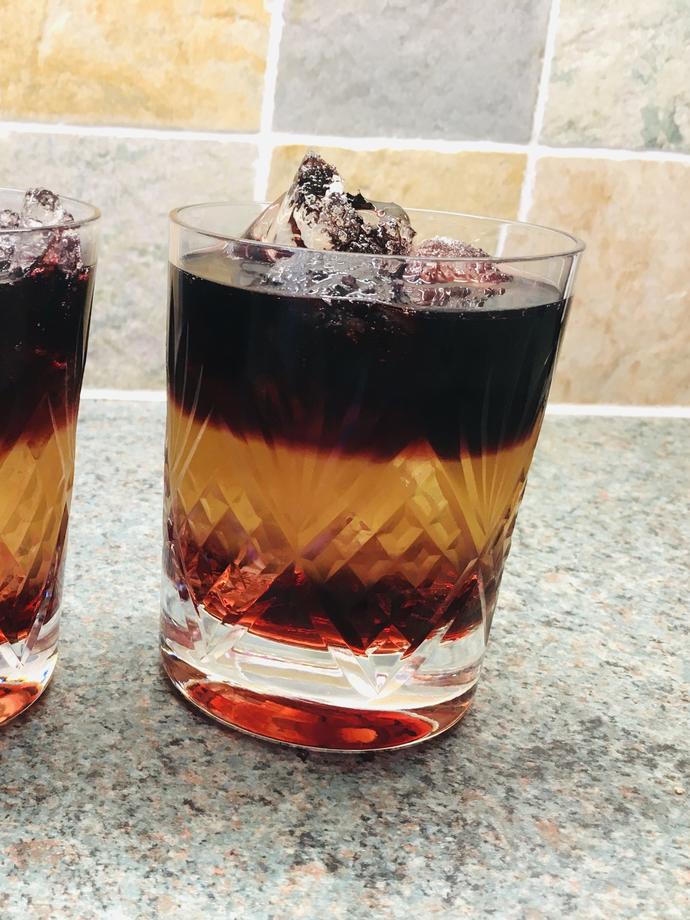Triple Sour 👍

Recipe
10ml cranberry syrup
30ml bourbon whiskey (or rye)
10ml lemon juice
10ml sugar syrup
30ml red wine
Pour the cranberry syrup into a rocks glass, then fill up the glass with ice. Shake the whiskey, lemon juice and sugar syrup together with ice and strain gently into the glass, disturbing the cranberry syrup as little as possible. Pour the wine on top, again trying not to disturb the drink, perhaps by pouring over a teaspoon.
Since I first tried the New York sour I've been fascinated by layered drinks, and have been wanting to take the whole thing further by making a good-tasting drink with three distinct layers. I tried and failed to do this at New Year, using port as the bottom layer; it just all blurred in together and didn't look good at all. So I approached the problem scientifically.
The thing that keeps layers in drinks from mixing is density. The red wine floats on a New York sour because it's less dense than the whiskey sour underneath. This is largely because of sugar content: sugar is very dense in solution.
If you want to see this in action, try making some sugar syrup. Most of my recipes include "sugar syrup", by which I mean 1:1 simple syrup. You make this by mixing equal weights of sugar and water, and if you do this you'll notice how dense sugar is. If you mix 100g of water and 100g of sugar, you end up with 200g of syrup, but in the jug it only measures about 160ml, much denser than the 200ml you'd expect from fresh water. Whiskey sour is sweeter than red wine, largely due to the syrup in it, so it should be no surprise that it is denser. In fact, in an early experiment I tried a less sweet whiskey sour, with half as much sugar, and it mixed with the wine much more easily. Take this lesson: if you prefer a drier cocktail, you might end up with more blurring!
Now, what we want is a third layer at the bottom. We've already established that we need something more sugary than whiskey sour, and that's easy enough. The other criterion is a bright colour, which will stand out from the pale liquid above it. I took a look at my drinks cabinet, and I had several syrups that I thought could work: grenadine and strawberry both fit the bill, and I tried the grenadine in an early attempt; but cranberry was the winner, with its sharp tartness cutting through the sickly sugar beautifully, and even acting as a curious mirror to the dry fruit flavour of the red wine. Monin sell a standard cranberry syrup which you can get online or in bottle shops. Finally, we had a recipe!
If I say so myself, this is an excellent cocktail. Aside from the novelty and the look of the thing, the flavours work very well together, and the complexity of the changing flavours as you work your way down makes every sip interesting. I'm going to play with the proportions, but I think I've got something that really works here.
Next experiment: make the bottom layer green ("traffic light sour"?) possibly using sirop de menthe or waltmeister. Stay tuned.
Comments